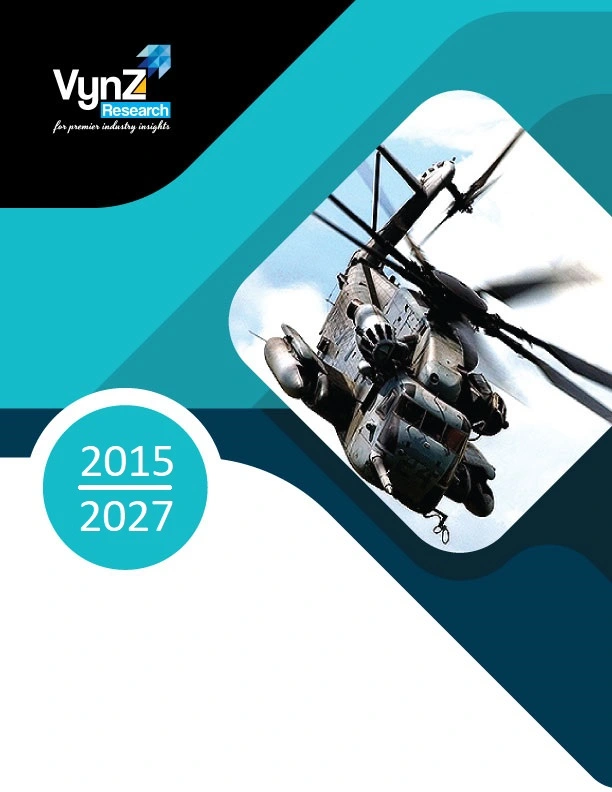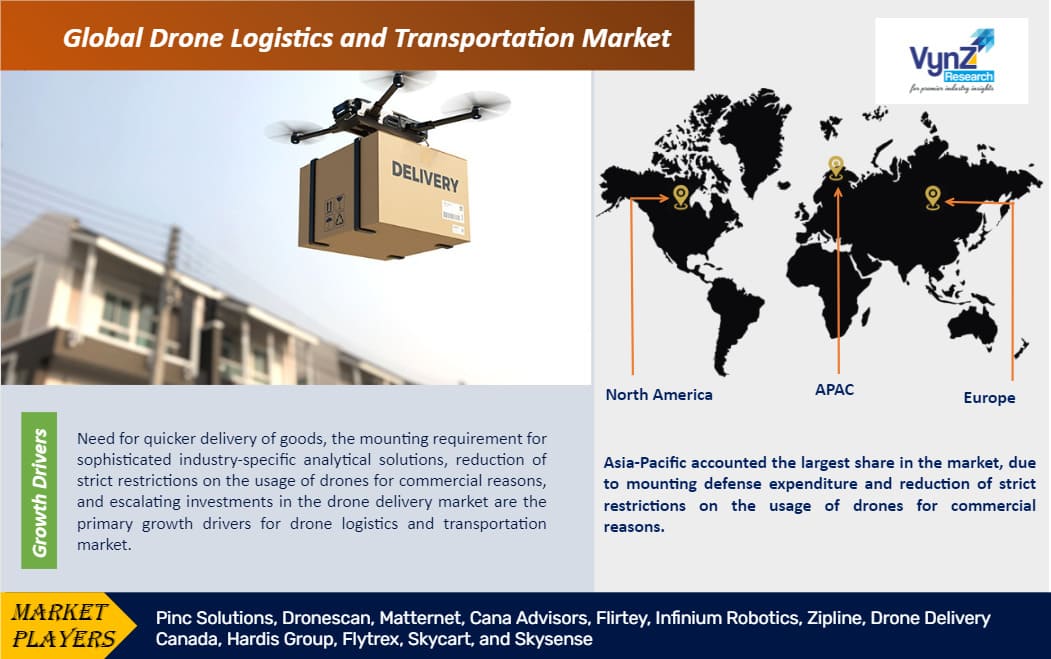| Status : Upcoming | Report Code : VRAD12003 | Industry : Aerospace and Defense | Available Format :

|

Global Drone Logistics and Transportation Market – Analysis and Forecast (2025-2030)
Industry Insights by Solution (Shipping Solution, Traffic Management, Software, Warehousing & Distribution, and Infrastructure), by Sector (Commercial and Military), and by Drones (Freight Drones, Medical/ Ambulance Drones, and Passenger Drones)
Industry Overview
The Global Drone Logistics and Transportation Market Size is expected to reach to around USD 53.8 billion during the forecast period from USD 9.03 billion in 2023, growing at a CAGR of 50.5%.
Drone is the common name for the Unmanned Aerial Vehicles (UAVs). These vehicles typically use advanced drone technology for delivery of goods and materials or for surveillance. This technology helps in overcoming the customary challenges of on-road transportation, such as traffic congestion, limited accessibility, delays in delivery, and others.
In addition, drone logistics and transportation offer several other benefits including reduced cost of transportation, efficient delivery, and wider reach to challenging locations and remote places.
Drones are typically used to transport a wide range of products or packages, large and small. It is also required to deliver medical supplies and essentials in hard-to-reach areas quickly. The most significant benefit of drone delivery over on-road delivery is that it takes less time to reach the destination.
In addition, it is also used for border surveillance, to resupply soldiers with equipment, spares, food, and ammunition on the battlefield.
The global drone logistics and transportation market is divided by solutions into shipping, traffic management, software, infrastructure, and other segments with the shipping solution segment expected to grow more during the forecast period.
It is also divided by sectors into commercial and military segments where the commercial sector reigns supreme in the global drone logistics and transportation market.
Divided according to the drones, the market segments are freight drones, medical or ambulance drones, and passenger drones where the freight drones dominate the market and will be used extensively for first-mile and last mile deliveries.
The range of the drones divides the global drone logistics and transportation market as well into close range, short range, mid-range, and long-range segments where the close-range segment is expected to growth more than the others.
The components of the drones divide the global drone logistics and transportation market into hardware, software, and services segments where the hardware segment dominates the market and will continue to contributes the major share.
 Drone Logistics And Transportation Market Segmentation
Drone Logistics And Transportation Market Segmentation
Insight by Solution
The global drone logistics and transportation market is divided according to the solution into shipping solutions, traffic management, software, warehousing & distribution, and infrastructure segments.
The infrastructure segment is further split into a charging station, use of unmanned aerial vehicles (UAV) control station and vertiports/landing pads and the software segment into inventory management, route planning, and live tracking.
Out of all these solutions, the shipping solution segment is expected to grow at the fastest rate in the forecast period due to the increased investment in the research and development of drones for package delivery.
Insight by Sector
Based on the market sector, the global drone logistics and transportation market is divided into commercial and military segments. Out of these two sectors, the commercial sector is expected to grow at a faster rate. This is attributed to the large number of deliveries in the logistics industry and e-commerce sector as well as the growing interest in the usage of unmanned aerial vehicles for the delivery of packages such as inventory management, delivery of medical supplies, food delivery, inventory tracking, and parcel delivery.
Insight by Drones
The global drone logistics and transportation market is divided on the basis of drones into freight drones, medical or ambulance drones, and passenger drones. The freight drones are further divided according to the cargo weight into less than 10 kg (delivery drones) and more than 10 kg (cargo drones). Among these categories, the less than 10 kg (delivery drones) segment contributes to the larger share in the market. This is mainly attributed to the growing need for drones for first-mile and last mile deliveries.
Insight by Range
According to the range of the drones, the global drone logistics and transportation market is divided in to close range, short range, mid-range, and long-range segments.
Out of all these segments, it is the close-range segment that is the dominant player in the market contributing more than half of the market share. These drones operate within a limited range usually ranging within a couple of kilometers from the base.
The most significant reasons for the popularity and significant growth of the close-range drones include their ability to handle last-mile deliveries most efficiently. Also, it is attributed to their quick delivery. In addition, the growth of this specific segment is attributed to the supportive regulatory environment for commercial use.
Insight by Component
According to the components of the drones, the global drone logistics and transportation market is divided into hardware, software, and services segments.
Out of these three segments, the hardware segment dominates the market being the largest contributor to the market in terms of revenue. Several hardware components such as drones, propulsion systems, batteries, sensors, and cameras are necessary for its proper functioning.
Over time, as drone technology develops, the demand for top-quality hardware components will be needed with greater capabilities for higher performance. Moreover, innovations in hardware will result in longer flight periods, improved navigation systems, and better cargo capacity which will foster the adoption and development of new drone technology.
Global Drone Logistics and Transportation Market Report Coverage
|
Report Metric |
Details |
|
Historical Period |
2018 - 2023 |
|
Base Year Considered |
2024 |
|
Forecast Period |
2025 - 2030 |
|
Market Size in 2024 |
U.S.D. 0.87 Billion |
|
Revenue Forecast in 2030 |
U.S.D. 15.9 Billion |
|
Growth Rate |
49.5% |
|
Segments Covered in the Report |
By Solution, By Sector, and By Drones |
|
Report Scope |
Market Trends, Drivers, and Restraints; Revenue Estimation and Forecast; Segmentation Analysis; Impact of COVID-19; Companies’ Strategic Developments; Market Share Analysis of Key Players; Company Profiling |
|
Regions Covered in the Report |
North America, Europe, Asia-Pacific, Middle East, and Rest of the World |
Industry Dynamics
Industry Trends
Use of sophisticated technologies such as AI, cloud computing, IoT, wireless charging, and others is a notable trend in this segment.
The major players in the market are investing on technologically advanced products into their portfolio to meet the growing demand of the consumers.
Most major logistics service providers are also investing a lot of money to integrate this technology into their services to make their existing business model much more efficient.
This disruptive technology has a wide range of application and recently the retail market has gained a lot by using them for last mile delivery. This inexpensive and convenient inclusion will shape the future of te retail industry resulting in their higher investments in this technology.
Drone Logistics And Transportation Market Growth Drivers
One of the most significant factors that drives the growth of the global drone logistics and transportation market is the growing need for faster delivery of goods.
In addition, the growing need for advanced industry-specific analytical solutions and relaxation of restrictions on the usage of drones for commercial reasons are also facilitating the growth of the global drone logistics and transportation market.
Moreover, there is an increase in the investments in the drone delivery market which is pushing its growth as well.
Usage of drones in different sectors such as by several vendors at different levels of the value chain, cargo delivery in military operations, and delivery services in remote and geographically challenging areas are also helping the global drone logistics and transportation market to grow.
Drone Logistics And Transportation Market Challenges
Concerns over battery life and bandwidth, strict restrictions on the commercial usage, issues with delivery authentication, cybersecurity issues, concerns over safety during transit and package drop, and lack of skilled personnel are the major hindrances for the growth of global drone logistics and transportation market.
Drone Logistics And Transportation Market Opportunities
The significant advancements in drone technology that allows higher payload capacity, longer flight ranges, and improved navigation systems, are creating new growth opportunities for the global drone logistics and transportation market.
The ability to cut down delivery time and cost is also creating extensive opportunities for growth for this market, especially in the healthcare industry. It has the potential to revolutionize transportation of medical supplies in disaster-stricken remote areas.
The fact that it reduces environmental impacts and congestion to streamline operations are also creating new opportunities for the growth of this market.
Additionally, the market includes various supporting technologies and services, such as drone delivery platforms, route optimization software, and maintenance and repair services.
Drone Logistics And Transportation Market Geographic Overview
The Asia-Pacific region contributes to the larger share of the market due to growing expenditure on defense and relaxation of restrictions on the usage of drones for commercial reasons.
North America is expected to grow at a rate during the forecast period due to increasing adoption of drones for package delivery by companies such as Amazon and Google. In addition, the increase in military budgets and growing need for UAVs from the commercial and military sectors are also fueling the growth of the global drone logistics and transportation market in this region.
Drone Logistics And Transportation Market Competitive Insight
Key players in the drone logistics and transportation market are catering to the demand of these devices by investing on technologically advanced products in their product portfolio across the globe. Flirtey and Domino's Pizza Enterprises Ltd began independent distribution of pizzas from Domino's stores to exclusive customer homes. Pinc Solutions, Dronescan, Matternet, Cana Advisors, Flirtey, Infinium Robotics, Zipline, Drone Delivery Canada, Hardis Group, Flytrex, Skycart, and Skysense are the key players offering drone logistics and transportation.
Recent Developments by Key Players
Matternet (world’s leading urban drone delivery system) has announced that its partner, Ameriflight, the nation’s largest Part 135 Cargo airline, received approval from the Federal Aviation Administration (FAA) to operate the Matternet M2 for commercial delivery. Ameriflight became the second operator in the U.S. to operate the Matternet M2. Combined. This partnership has become the first fully operational, large-scale drone airline in the United States and will focus on health care and e-commerce deliveries across the country.
Frequently Asked Questions
Purchase Options
Latest Report
Research Methodology
- Desk Research / Pilot Interviews
- Build Market Size Model
- Research and Analysis
- Final Deliverabvle
Connect With Our Sales Team
- Toll-Free: 1 888 253 3960
- Phone: +91 9960 288 381
- Email: enquiry@vynzresearch.com
Drone Logistics and Transportation Market
